WHMIS 1988 - Classification
On this page
- What are WHMIS classes or classifications?
- What is a Class A - Compressed Gas?
- What is a Class B - Flammable and Combustible Material?
- What is a Class C - Oxidizing Materials?
- What is a Class D - Poisonous and Infectious materials?
- What is a Class E - Corrosive Material?
- What is a Class F - Dangerously Reactive Materials?
- Are there any hazardous materials not included in WHMIS?
What are WHMIS classes or classifications?
Back to topWHMIS (Workplace Hazardous Materials Information System) uses classifications to group chemicals with similar properties or hazards. The Controlled Products Regulations specifies the criteria used to place materials within each classification. There are six (6) classes although several classes have divisions or subdivisions. Each class has a specific symbol to help people identify the hazard quickly. The classes are:
Class A - Compressed Gas
Class B - Flammable and Combustible Material
Division 1: Flammable Gas
Division 2: Flammable Liquid
Division 3: Combustible Liquid
Division 4: Flammable Solid
Division 5: Flammable Aerosol
Division 6: Reactive Flammable Material
Class C - Oxidizing Material
Class D - Poisonous and Infectious Material
Division 1: Materials causing immediate and serious toxic effects
Subdivision A: Very toxic material
Subdivision B: Toxic materialDivision 2: Materials causing other toxic effects
Subdivision A: Very toxic material
Subdivision B: Toxic materialDivision 3: Biohazardous Infection Material
Class E - Corrosive material
Class F - Dangerously reactive material
What is a Class A - Compressed Gas?
Back to top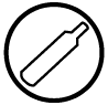
Any material that is normally a gas which is placed under pressure or chilled, and contained by a cylinder is considered to be a compressed gas. These materials are dangerous because they are under pressure. If the cylinder is broken, the container can 'rocket' or 'torpedo' at great speeds and this is a danger to anyone standing too close. If the cylinder is heated (by fire or rise in temperature), the gas may try to expand and the cylinder will explode. Leaking cylinders are also a danger because the gas that comes out is very cold and it may cause frostbite if it touches your skin (for example: carbon dioxide or propane). Common examples include: compressed air, carbon dioxide, propane, oxygen, ethylene oxide, and welding gases. The hazard symbol is a picture of a cylinder or container of compressed gas surrounded by a circle.
Additional dangers may be present if the gas has other hazardous properties. For example: propane is both a compressed gas and it will burn easily. Propane would have two hazard symbols - the one for a compressed gas and another to show that it is a flammable material.
What is a Class B - Flammable and Combustible Material?
Back to top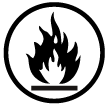
Flammable means that the material will burn or catch on fire easily at normal temperatures (below 37.8 degrees C or 100 deg F). Combustible materials must usually be heated before they will catch on fire at temperatures above normal (between 37.8 and 93.3 deg C or 100 and 200 deg F). Reactive flammable materials are those which may suddenly start burning when it touches air or water, or may react with air or water to make a flammable gas. The material may be a solid, liquid or gas which makes up the different divisions that fall under this class. Common examples include: propane, butane, acetylene, ethanol, acetone, turpentine, toluene, kerosene, Stoddard solvent, spray paints and varnish. The symbol for this class is a flame with a line under it inside a circle.
What is a Class C - Oxidizing Materials?
Back to top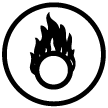
Oxygen is necessary for a fire to occur. Some chemicals can cause other materials to burn by supplying oxygen. Oxidizers do not usually burn themselves but they will either help the fire by providing more oxygen or they may cause materials that normally do not burn to suddenly catch on fire (spontaneous combustion). In some cases, a spark or flame (source of ignition) is not necessary for the material to catch on fire but only the presence of an oxidizer. Oxidizers can also be in the form of gases (oxygen, ozone), liquids (nitric acid, perchloric acid solutions) and solids (potassium permanganate, sodium chlorite). Some oxidizers such as the organic peroxide family are extremely hazardous because they will burn (they are combustible) as well as they have the ability to provide oxygen for the fire. They can have strong reactions which can result in an explosion. The symbol for oxidizing materials is an "o" with flames on top of it inside a circle.
What is a Class D - Poisonous and Infectious materials?
Back to topClass D materials are those which can cause harm to your body. They are divided into three major divisions.
Division 1: Materials Causing Immediate and Serious Toxic Effects
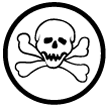
These are materials that are very poisonous and immediately dangerous to life and health. Serious health effects such as burns, loss of consciousness, coma or death within just minutes or hours after exposure are grouped in this category. Most D-1 materials will also cause longer term effects as well (those effects that are not noticed for months or years). Examples of some D-1 materials include carbon monoxide, sodium cyanide, sulphuric acid, toluene-2,4-diisocyanate (TDI), and acrylonitrile. The symbol for Class D - Division 1 (D-1) is a skull and crossed bones inside a circle.
Division 2: Materials Causing Other Toxic Effects
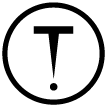
These materials are poisonous as well. Their effects are not always quick, or if the effects are immediate but they are only temporary. The materials that do not have immediate effects, however, may still have very serious consequences such as cancer, allergies, reproductive problems or harm to the baby, changes to your genes, or irritation / sensitization which have resulted from small exposures over a long period of time (chronic effects).
Division 2 of Class D has two subclasses called D2A (very toxic) and D2B (toxic). While it is not a legal requirement for the WHMIS sub-classification to be reported on the Material Safety Data Sheet (MSDS) nor is it a requirement for classes D2A or D2B to be distinguished on the label, it is often possible to make this distinction using the health hazard information on the label and/or the MSDS.
Products are typically classified as D2A (very toxic) if the chemical has been shown to be carcinogenic, embryo toxic, teratogenic, mutagenic (to reproductive cells), reproductive toxic, sensitizer (to respiratory tract) or chronic (long-term) toxicity (at low doses). Subdivision D2B (toxic) covers mutagenic (to non-reproductive cells), sensitization of the skin, skin or eye irritation, as well as chronic toxic effects.
Examples include: asbestos fibres, mercury, acetone, benzene, quartz silica (crystalline), lead and cadmium. The symbol for materials causing other toxic effects looks like a "T" with an exclamation point "!" at the bottom inside a circle.
Division 3: Biohazardous Infectious Materials

These materials are organisms or the toxins they produce that can cause diseases in people or animals. Included in this division are bacteria, viruses, fungi and parasites. As these organisms can live in body tissues and fluids, they should be treated as toxic. Urine and feces should be treated as toxic only if they are visibly contaminated with blood. Biohazardous infectious materials are usually found in a hospital, health care facility, laboratories, veterinary practices and research facilities. Workers in these places do not usually know which tissues or fluids contain dangerous organisms. For this reason, the workers assume that every sample is dangerous and proper protection is used all the time. Examples of biohazardous infectious materials include the AIDS/HIV virus, Hepatitis B and salmonella. The symbol for this division looks like three "c"s joined together with a little circle in the middle all inside a circle.
What is a Class E - Corrosive Material?
Back to top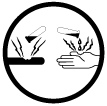
Corrosive is the name given to materials that can cause severe burns to skin and other human tissues such as the eye or lung, and can attack clothes and other materials including metal. Corrosives are grouped in this special class because their effects are permanent (irritants whose effects may be similar but temporary are grouped in Class D-2). Common corrosives include acids such as sulphuric and nitric acids, bases such as ammonium hydroxide and caustic soda and other materials such as ammonia, chlorine, and nitrogen dioxide. The symbol for a corrosive is a picture of two test tubes pouring liquid on a bar (piece of metal) and a hand with lines coming off of them inside a circle.
What is a Class F - Dangerously Reactive Materials?
Back to top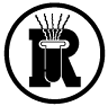
A material is considered to be dangerously reactive if it shows three different properties or abilities: first, if it can react very strongly and quickly (called "vigorously") with water to make a toxic gas; second, if it will react with itself when it gets shocked (bumped or dropped) or if the temperature or pressure increases; and thirdly, if it can vigorously join to itself (polymerization), break down (decomposition) or lose extra water such that it is a more dense material (condensation). If a material is dangerously reactive, it will most likely be described as "unstable". Most of these materials can be extremely hazardous if they are not handled properly because they can react in such a quick manner very easily. Examples of these products are ethyl acrylate, vinyl chloride, ethylene oxide, picric acid and anhydrous aluminum chloride. The symbol for dangerously reactive materials is a picture of a test tube with sparks or lines coming out of the tube surrounded by a letter "R" inside a circle.
Are there any hazardous materials not included in WHMIS?
Back to topYes. There are nine basic categories of materials that are not covered by WHMIS. When WHMIS was created it was recognized that a lot of safety information was already being transmitted to workers for many of these products under other laws. To prevent delay in starting WHMIS, exclusions were made.
They are:
- consumer restricted products (those products sold to people in regular stores that are already labelled following the rules of the Hazardous Products Act)
- explosives (as defined by the Explosives Act)
- cosmetics, drugs, food or devices (as defined by the Food and Drug Act)
- pest control products (pesticides, herbicides, insecticides, etc) (as defined by the Pest Control Products Act)
- radioactive materials (as defined by the Nuclear Safety and Control Act)
- wood and products made of wood
- a manufactured article
- tobacco or products made of tobacco
- hazardous wastes
Materials which fall under WHMIS follow the Transportation of Dangerous Goods Act and Regulations while they are in transport (shipment).
For several years, there have been proposals to make some of the above products follow the WHMIS laws. Most of the products that may be affected are the ones in categories 1, 2, 3, 4, and 5. However, there have been no changes to the WHMIS regulations yet.
- Fact sheet last revised: 2011-04-01
